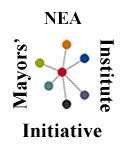The Mayor’s Institute on City Design is celebrating 25 years of persuading and preparing city mayors to be chief urban design official. And yet, for 24 of those years, no mayor of Memphis ever attended.
That changed last year with new Memphis Mayor A C Wharton attended a session in New York City. In keeping with the process for the gatherings, every mayor brings a design opportunity for their cities to receive the advice and design suggestions by a group of national experts in design, architecture, and placemaking. Mayor Wharton’s project involved Overton Square and he returned home with new ideas for reviving its role as hub of a functioning, healthy neighborhood.
From Citiwire:
Let’s take a trip back to 1985, perhaps the peak of anti-urbanism in this nation’s history. Suburbanization was in full force across the landscape. As Dolores Hayden has noted, “by 1980 one out of seven American workers earned a living building, selling, repairing, insuring, driving or servicing vehicles and highways.” Meanwhile, our cities were dealing with the painful legacy of failed urban renewal projects, trying to figure out what to do with acres and acres of bulldozed sites. The Reagan Administration was cutting funding from Community Development Block Grants, mass transit, and other urban programs. And Mayor Joe Riley of Charleston, South Carolina wrote a letter to Jaquelin Robertson, Dean of the University of Virginia School of Architecture, to propose that they collaborate on a forum to educate mayors about architecture, design, and planning.
Mayor Riley predicted a great revival of American cities, but asked “What kind of cities are being rebuilt?” He proposed that by creating “a program aimed at increasing the mayors sophistication and interest in urban design, we could have a substantial impact on the quality and development of American cities.”
One year later, they had teamed up with Adele Chatfield-Taylor at the National Endowment for the Arts and the first Mayors’ Institute on City Design (MICD) was held in Thomas Jefferson’s Academical Village at the University of Virginia in Charlottesville. The idea was at the same time both simple and ambitious. Just as Jefferson was both a politician and a designer, contemporary mayors have enormous influence over the physical design and shape of their cities. But they often lack training in how to use the powerful tools at their disposal. So why don’t we help them better understand how to use this authority?
“I was anxious about what we were doing,” Mayor Riley recalled at a gala celebration in Chicago last week to commemorate the 25th anniversary of the Mayors Institute. “But half-way throught the afternoon of the first session, the Mayor of Allentown, Pennsylvania said ‘stop — I need to call my office because I just realized that we’re doing something wrong and please don’t do anything until I come back.’ He ran out and found a phone in Thomas Jefferson’s Rotunda. That’s when I knew that we had created something of enormous value, that changed our mayors and changed our country.”
Twenty five years later, this idea has powered 50 national conferences and many more regional institutes. Over 600 designers and more than 850 mayors have participated in these forums, and it’s clear that those folks in Charlottesville were onto something very powerful indeed.
The Institutes follow a common agenda. Instead of asking public officials to show off their successes, the mayors (there are five to eight at each session) bring a problem. They present a case study to a team of planners, urban designers, landscape architects, preservationists and fellow mayors about something they are struggling with back home. How to revitalize a downtown shopping district. Creating attractive gateways to a community. Connecting green spaces to build a park system. Locating a convention center or a sports arena. Preserving an historic neighborhood. Establishing design guidelines. Parking. Housing. Retail. The list goes on. Every city is dealing with these issues, and can learn from the experience of other communities.
Around a large table, the mayors and resource team members discuss the projects and how they would approach them. While the mayors get excellent advice on their specific case studies from the resource team, the real goal of the Institute has always been to educate the mayors, to make them better consumers and stronger advocates for their communities.
At the gala celebration last week, the legacy of the Mayors Institute on City Design was in full force. In the ornate Grand Ballroom of the Chicago Hilton (a room to make Louis XIV envious), Mayors Nutter of Philadelphia, Villaraigosa of Los Angeles, and Daley of Chicago and many others talked about the importance of the MICD vision for them in their communities. NEA Chairman Rocco Landesman described projects that came out of the institute sessions. Ron Bogle from the American Architectural Foundation, which organizes the forums, discussed the achievements of MICD directors. On the second day, federal officials heard from mayors and designers about the resources and partnerships that they need to build sustainable communities in the 21st century. Marilyn Taylor, Dean of Penn Design, delivered a particularly strong message about the kinds of investments and partnerships that communities are looking for from their federal government.
Perhaps the strongest legacy of the Institute is how conventional its message has become over the past 25 years. Mayors understand the attractiveness of mixed use communities and 24/7 neighborhoods. They understand the benefits of master planning, historic preservation, arts districts, design guidelines, new urbanism, smart growth, sustainability and many more buzzwords. As a regional planner, I found myself wishing that we had made even a fraction of this progress on the need for integrated infrastructure systems and capital investments, but hopefully that’s yet to come.
As the sessions wound down in Chicago, it was thrilling to take a step back and think about what Mayor Riley’s epistle has achieved over the past 25 years, and its place in planning history. I’d argue that it should be taught in our public schools, just as Daniel Burnham’s plan for Chicago was part of the curriculum in public schools for many decades. After all, not since Jane Jacobs wrote a book about her experiences in Greenwich Village has a document had such a profound – and beneficial – impact on American cities.





One more reason to love the changes Mayor Wharton has set in motion.
Did any of you attend the NYC session? I’d like to know what, specifically, was suggested for improving Overton Square.
Ashley,
This from the CA concerning the mayor’s participation:
“Charles “Chooch” Pickard, executive director of the Memphis Regional Design Center, said the recommendation comprises three parts:
Create a zoning overlay plan, which the city is already doing. In fact, the draft should be ready for public response in just a few weeks, Pickard said.
The Midtown Plan will provide guidelines for redevelopment that’s more appropriate for urban settings. It will also give developers predictability, something last winter’s would-be developers of Overton Square said they really wanted.
Create incentives to attract potential developers to Overton Square by having the city make some streetscape improvements in the area.
And at Overton Square’s main intersection, Madison at Cooper, eliminate the sweeping, curving right turn motorists eastbound on Madison can now take to go south on Cooper.
Those vehicles only have to yield, not stop at the light, which makes the spot less safe for pedestrians, Pickard said.
Plus, those curving lanes could be reclaimed to make a bigger, parklike space at the corner.”
http://www.commercialappeal.com/news/2010/may/14/memphis-mayor-c-wharton-gets-expert-advice-revital/
Urbanut – Thanks a bunch.
What would you recommend for that area, especially concerning the streetscape improvements? Along with a reduction of automobile lanes and an addition of bike lanes on Madison (fingers crossed!), I’d like to see the landscaped medians extended down Madison and added to Cooper.
Along with all the great projects you mentioned, I would like to see a major reinvestment in the area’s sidewalks including crosswalk improvements and enhanced lighting. Simply rebuilding the sidewalks would be a big step forward. Installing additional pedestrian scaled street lights in between existing light poles would increase safety and perception of the area. What would also be great is if the building owners/ managers took matters into their own hands by doing something creative such as stringing “Christmas Lights” back and forth over Madison to not only increase the area’s visibility but to draw attention to the districts night life. It would be akin to visible public art.